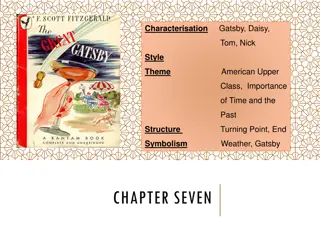
Effective Communication Skills in the Workplace
Enhance your workplace communication skills by learning about active listening, assertive communication, and more. Understand the importance of listening actively, communicating assertively, and utilizing these skills to build better relationships and avoid misunderstandings.
Download Presentation

Please find below an Image/Link to download the presentation.
The content on the website is provided AS IS for your information and personal use only. It may not be sold, licensed, or shared on other websites without obtaining consent from the author. If you encounter any issues during the download, it is possible that the publisher has removed the file from their server.
You are allowed to download the files provided on this website for personal or commercial use, subject to the condition that they are used lawfully. All files are the property of their respective owners.
The content on the website is provided AS IS for your information and personal use only. It may not be sold, licensed, or shared on other websites without obtaining consent from the author.
E N D
Presentation Transcript
B123 Chapter 4 Working with Others
Focus area Active listening 79-80 Communicating assertively 81-82 Negotiating 82-84 Giving and receiving feedback 84-85 Brainstorming 95 Giving presentations 99-101
Active Listening Listening is essential Attention can wander , mind leaps to the next question, making judgments before others finish. Workplace requires active listening Like : giving or receiving instructions, disagreeing with a colleague,discussing a problem, coaching or mentoring a new colleague, conducting an appraisal interview.
Guidelines for active listening Give people your attention Be ready to paraphrase Use questions if you do not understand. Acknowledge the other persons feelings. Encourage if the other person appears uncertain. Do not react or respond in other ways until it is clear that the other person has finished.
Reasons for using active listening To avoid misunderstandings Building relationships Encourage people to say more and frank Enable people to become clearer
Communicating assertively Being assertive is a core communication skill. Being assertive means that you express yourself effectively and stand up for your point of view, while also respecting the rights and beliefs of others. Being assertive can also help boost your self-esteem and earn others' respect. This distinguishes it from aggression (fight) which involves violating the rights of others , and from evasion (flight) which involves respecting the rights of others at the expense of your own. Aggressive, Passive, Assertive Contexts : stating your own views, disagreeing with other s views, making a request, refusing a request, offering criticism, responding to criticism, giving praise, responding to praise.
Communicating assertively Scripting an assertive response Prepare : Clarify your purpose and ensure that you approach the other person and the situation in a positive frame of mind Identify the problem and state how you feel and your wants Respect the other person
Limits to assertiveness They take no account of structural and political imbalances in organization or society at large. (Manager and Clerk) Dominant or powerful groups may interpret assertion from members of other groups as aggressive even if no hostility or offence is intended (Gender, Ethnicity, ) Individuals may be encouraged to take on responsibility for righting wrongs that are outside their control. Assertiveness can ignore collective virtues such as the solidarity of working for a cause. Some cultures have more respect for tact than honesty and may expect deference on both sides. Assertiveness may not be universally appropriate
Negotiating A successful negotiator tries to find a win- win solution in which both sides benefit. 4 things that assist negotiation Separate the people from the problem. Focus on interest not positions Generate options for mutual gain Agree criteria for solutions
Negotiating Separate the people from the problem : Tease out the relationship issues from the substantive issue to be negotiated. Focus on interest not positions : Try to identify the more general interests and concerns of the parties involved rather than specific positions. Generate options for mutual gain : There is no one right solution. Search for alternatives and mutually advantageous outcomes. Be prepared to develop and explore innovative options and suspend judgment until late in the process. Agree criteria for solutions : Try to establish a set of essential and desirable criteria that the outcome of negotiation should meet.
Behavior that affect negotiations Skilled negotiators avoid the following negative behavior: Defense/attack spirals Irritators Argument dilution Behavior chains (Question and Summarizes) Counter proposal
Behavior that affect negotiations Defense/attack spirals : Sequences of attacking statements and aggressive defenses are unhelpful. Irritators :Words and phrases which add nothing to the content and serve to irritate the other parties should not be used. Argument dilution: Don t clutter your argument by including too many points or digressions. Identify and adhere to the main ,strong points of your case. Behavior chains : (Question and Summarizes): In behavior chains someone asks a question, summarizes and puts some information into the proceedings, all in one statement. Others do not know which bit of the input to respond to and get confused Counter proposal : When one party immediately responds to a proposal from the other side with a proposal of their own , little is achieved. The effect is to signal that I haven't listened to a word you have said .
Behavior that affect negotiations Skilled negotiators demonstrate the following positive behavior: Test understanding and summarize Flag or signal Ask lots of questions Explain how they feel Review their performance
Behavior that affect negotiations Test understanding and summarize : Check that everyone understands the things in the same way and clarify the structure of any agreement. Helps build relationships. Flag or signal : Tell people what sort of behavior . Example : Could I ask you, make a suggestion, . Ask lots of questions : deeper understanding of other party, arrive at win-win situation. Explain how they feel : Openness helps in creating trust and enhances relationship. Review their performance : reflection helps in identifying strengths and weaknesses of our approach.
Dealing with difficulties If your negotiation seems to be failing because someone else is being difficult: Do not react Look at the situation from the other persons viewpoint. Do not reject reframe Make it easy to say yes Make it hard to say no
Dealing with difficulties Do not react : Deal with your behavior, not oppenents.Keep focused on the desired outcomes and concentrate on securing agreement. Look at the situation from the other persons viewpoint : It is harder for a person to be hostile if you are listening to them and acknowledging what they say and feel. Do not reject reframe : offering new ways of looking at problem. Make it easy to say yes : Involving other party in crafting an agreement. Help them save face and find ways of presenting the solution as a victory. Make it hard to say no : Educate the other party to the costs of saying no . Warn, do not threaten. Exercise restraint.
Giving and receiving feedback Feedback on other people's performance of various activities who work with you or for you. Give praise where it is deserved Be positive about yourself. Give compliments.
Giving and receiving feedback Feedback on other people's performance of various activities who work with you or for you. Give praise where it is deserved : people are willing to hear justifiable negative feedback, if they are confident that you will also praise them when they have done a good job. Be positive about yourself : Develop support mechanisms Give compliments : Look for opportunities to praise a person s work
Giving feedback Give positive feedback first Say things in a supportive way . Soften the negatives Criticize only behavior that can be changed Suggest ways in which performance might be improved Place the feedback in the context of relationship Make your feedback well-timed, clear and direct. ( Piccinin and Mason,1991)
Receiving feedback Feedback is a rich source of learning Listen actively Ask for precision Agree/disagree with criticism : Acknowledge what is true. State your disagreement if anything is not true. State what you have learned for future action and behavior from your feedback. Give information to correct misunderstandings Set limits : Tell the critic how you want to receive feedback if you have been criticized inappropriately. ( Piccinin and Mason,1991)
Techniques for group work Effective group work benefits from bringing together different experiences and perspectives. Many techniques for group work are structured ways of drawing on these benefits.
Brainstorming Two principles apply to the process: The operation between being creative and being judgment. Quantity breeds quality : one idea stimulate the other, good ideas are rare, so generate as many as possible. These principles leads to 4 practical rules: No criticism Freewheel The more ideas, the better Hitch-hike (building and improving quality of ideas)
Brainstorming These principles leads to 4 practical rules: No criticism : postponement of judgment, both by words and gestures. Freewheel : Expression of idea must be unrestricted, random thoughts, ideas, images , possibilities, The more ideas, the better Hitch-hike : building and improving quality of ideas and contribute to sense of team working.
Brainstorming : A helpful process Enjoyable and productive Approach to proposals and ideas There should not be any barriers to the process of generation Purpose of the session is to generate ideas
Giving Presentations To communicate, generate ideas, gather valuable feedback. Persuade others to follow your leadership
Giving presentations Steps in preparing a presentation Plan : identify the message, main points, how long, Audience : identify need , arousing interest Teamwork : Agree on how to divide the topic Prepare : information, evidence, examples,..
The Presentation Relax Get attention and arouse interest Tell listeners when they can ask questions Be easy to listen to Monitor your audience Watch the time Dealing with questions
The Presentation Relax : comfortable in front of audience, consciously slow your pace, particularly if you have a tendency to speak quickly when nervous. Get attention and arouse interest : Wait until the audience is quiet, look directly and make opening statement. Tell listeners when they can ask questions : agreement with the audience. Be easy to listen to : use conversational way of speaking. Referring notes, look at your audience as often as possible.
The Presentation Monitor your audience : Watch for signs your audience is not fully engaged : check with audience, change your tone and body language, coffee break, . Watch the time : Keep up the time spent on each parts as planned, Dealing with questions : anticipate some difficult questions and prepare some responses, no need to answer every question, rephrasing a question and answering it, deal with them after the talk, check on number of questions based on the available time, Q&A is very valuable.
Planning Planning well is particularly essential when working with others. The following plan gives eight stages which should be considered before undertaking a group activity, to ensure that the group s objectives will be accomplished.
Planning Define the objectives-and your measures of success. Generate and evaluate the options Identify the activities Sequence the activities Identify the resources Review the plan Prepare the action plans, schedules and progress markers Monitor and control : adjust tasks, re-plan, or revise objectives if necessary.






















